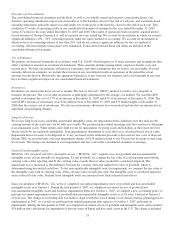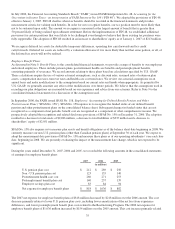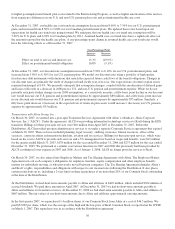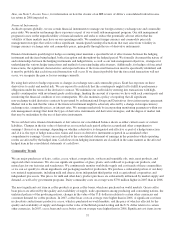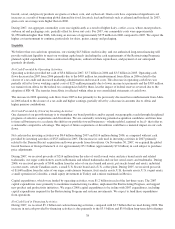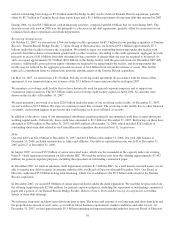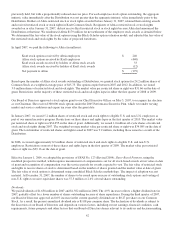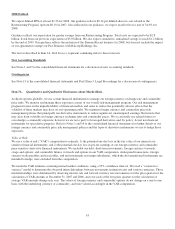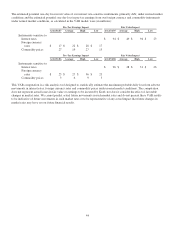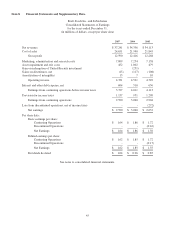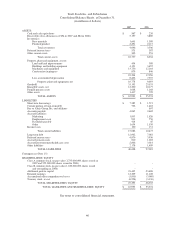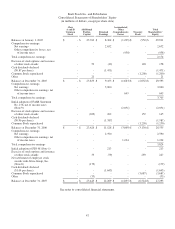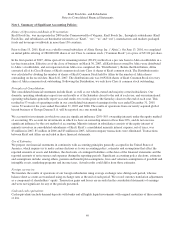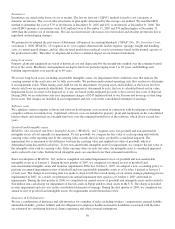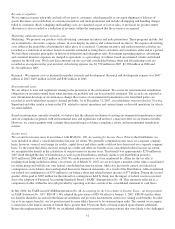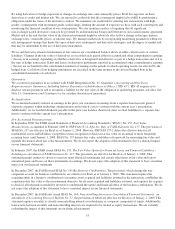Kraft 2007 Annual Report Download - page 58
Download and view the complete annual report
Please find page 58 of the 2007 Kraft annual report below. You can navigate through the pages in the report by either clicking on the pages listed below, or by using the keyword search tool below to find specific information within the annual report.
2008 Outlook
We expect diluted EPS of at least $1.56 for 2008. Our guidance reflects $0.34 per diluted share in costs related to the
Restructuring Program, up from $0.19 in 2007. Also reflected in our guidance, we expect an effective tax rate of 34.0% for
2008.
Guidance reflects our expectation for greater savings from our Restructuring Program. Total costs are expected to be $2.8
billion, down from our previous expectation of $3.0 billion. We also expect cumulative, annualized savings to reach $1.2 billion
by the end of 2009. Our guidance reflects the inclusion of the Danone Biscuit business for 2008, but does not include the impact
of our agreement to merge our Post Business with Ralcorp Holdings, Inc.
The factors described in Item 1A, Risk Factors, represent continuing risks to these forecasts.
New Accounting Standards
See Notes 1 and 9 to the consolidated financial statements for a discussion of new accounting standards.
Contingencies
See Note 15 to the consolidated financial statements and Part I Item 3. Legal Proceedings for a discussion of contingencies.
Item 7A. Quantitative and Qualitative Disclosures about Market Risk.
As Kraft operates globally, we use certain financial instruments to manage our foreign currency exchange rate and commodity
price risks. We monitor and manage these exposures as part of our overall risk-management program. Our risk management
program focuses on the unpredictability of financial markets and seeks to reduce the potentially adverse effects that the
volatility of these markets may have on our operating results. We maintain foreign currency and commodity price risk
management policies that principally use derivative instruments to reduce significant, unanticipated earnings fluctuations that
may arise from volatility in foreign currency exchange rates and commodity prices. We occasionally use related futures to
cross-hedge a commodity exposure, however we are not a party to leveraged derivatives and, by policy, do not use financial
instruments for speculative purposes. Refer to Notes 1 and 14 to the consolidated financial statements for further details of our
foreign currency and commodity price risk management policies and the types of derivative instruments we use to hedge those
exposures.
Value at Risk:
We use a value at risk (“VAR”) computation to estimate: 1) the potential one-day loss in the fair value of our interest rate-
sensitive financial instruments; and 2) the potential one-day loss in pre-tax earnings of our foreign currency and commodity
price-sensitive derivative financial instruments. We included our debt; short-term investments; foreign currency forwards,
swaps and options; and commodity futures, forwards and options in our VAR computation. Anticipated transactions, foreign
currency trade payables and receivables, and net investments in foreign subsidiaries, which the abovementioned instruments are
intended to hedge, were excluded from the computation.
We made the VAR estimates assuming normal market conditions, using a 95% confidence interval. We used a “variance/co-
variance” model to determine the observed interrelationships between movements in interest rates and various currencies. These
interrelationships were determined by observing interest rate and forward currency rate movements over the prior quarter for the
calculation of VAR amounts at December 31, 2007 and 2006, and over each of the four prior quarters for the calculation of
average VAR amounts during each year. The values of foreign currency and commodity options do not change on a one-to-one
basis with the underlying currency or commodity, and were valued accordingly in the VAR computation.
43


